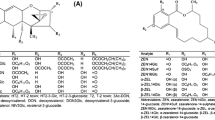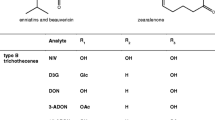Abstract
Fusarium mycotoxins such as deoxynivalenol (DON) can occur in cereals conjugated to glucose and probably also to other sugars. These conjugates, which are often referred to as “masked mycotoxins”, will not be detected with routine analytical techniques. Furthermore, it is suspected that the parent toxin may again be released after hydrolysis in the digestive tracts of animals and humans. Today, our knowledge of the occurrence of these compounds in cereal grains is limited. In this paper, a LC-MS/MS method for the simultaneous determination of DON, deoxynivalenol-3-β-d-glucoside (DON-3-glucoside), 3 acetyl-DON, nivalenol, fusarenon-X, diacetoxyscirpenol, HT-2 toxin, and T-2 toxin in naturally (n = 48) and artificially (n = 30) contaminated cereal grains (wheat, barley, oat, rye triticale) is reported. The method has also been applied to whole fresh maize plant intended for production of maize silage (n = 10). The samples were collected from the harvest years 2006–2010, The results show that DON-3-glucoside and DON co-occurred in cereal grains and, especially in several of the highly contaminated samples, the concentration of the glucoside can be relatively high, corresponding to over 37 % of the DON concentration. The DON-3-glucoside levels in both the naturally and in the artificially grain inoculated with Fusarium were second only to DON, and were generally higher than those of the other tested trichothecenes, which were found at low concentrations in most samples, in many cases even below the detection limit of the method. This argues for the importance of taking DON-3-glucoside into account in the ongoing discussion within the European Community concerning exposure re-evaluations for setting changed values for the tolerable intake for DON. Our results indicate that, in the naturally contaminated grains and in the Fusarium infested cereal grains (winter and spring wheat, oat, triticale), the concentration level of DON-3-glucoside is positively correlated to the DON content. When the DON concentration is high, then the content of DON-3-glucoside will most probably also be high and vice versa.

Similar content being viewed by others
References
Berthiller F, Dall’ Asta C, Scuhmacher R, Lemmens M, Adam G, Krska R (2005) Masked mycotoxins: determination of a deoxynivalenol glucoside in artificially and naturally contaminated wheat by liquid chromatography-tandem mass spectrometry. J Agric Food Chem 53:3421–3425
Berthiller F, Dall’ Asta C, Corradhi R, Marchelli R, Sulyok M, Kraska R, Adam G, Scuhmacher R (2009) Occurrence of deoxynivalenol and its 3-D-glucoside in wheat and maize. Food Addit Contam 26:507–511
Berthiller F, Kraska R, Domig KJ, Kneifel W, Juge N, Schuhmacher R, Adam G (2011) Hydrolytic fate of deoxynivalenol-3-glycoside during digestion. Toxicol Lett 206:264–267
Eriksen GS, Alexander J (eds) (1998) Fusarium toxins in cereals – a risk assessment. Nordic Councils of Ministers, TemaNord 1998
FAO/WHO (2011) Safety evaluation of certain contaminants in food. WHO Food Additive Series 63, Geneva
Gareis M, Bauer J, Thiem J, Pland G, Brabley S, Gedek B (1990) Cleavage of zearalenone-glycoside a “Masked” mycotoxin during digestion in swine. J Vet Med B37:236–240
Jørgensen LN, Henriksen KE (2008) Bekæmpelse af svampesygdomme i korn. In: Pesticidafprøvning 2007, DJF rapport Markbrug, no. 133, pp 18–70
Lancova K, Hajslova J, Poustka J, Krplova A, Zachariakova P, Sachambulla L (2008) Transfer of Fusarium mycotoxins and masked deoxynivalenol (deoxynivalenol-3-glucoside) from field barley through malt to beer. Food Addit Contam 25:732–777
Langseth W, Elen O (1997) The occurrence of deoxynivalenol in Norwegian cereals- differences between years and districts, 1988–1996. Acta Agric Scand Sect B Soil Plant Sci 47:176–184
Lemmens M, Scholz U, Berthiller F, Dall’ Asta C, Koutnik A, Schuhmacher R, Afam G, Buerstmayr H, Mesterhazy A, Kraska R, Ruckenbauer P (2005) The ability to detoxify the mycotoxin deoxynivalenol colocalizes with a major quantitative trait locus for fusarium head blight resistance in wheat. Mol Plant Microbe Interact 18:1318–1324
Miller JD (1994) Epidemiology of Fusarium ear diseases of cereals. In: Miller JD, Trenholm HL (eds) Mycotoxins in grain compounds other than aflatoxin. Eagan, St Paul, pp 19–36
Miller JD (2008) Mycotoxins in small grains and maize: old problems, new challenges. Food Addit Contam 25:219–230
Miller JD, Young JC, Trenholm HL (1983) Fusarium toxins in field corn. Time course of fungal growth and production of deoxynivalenol and other mycotoxins. Can J Bot 61:3080–3087
Nielsen LK, Jensen JD, Nielsen GC, Jensen JE, Spliid NH, Thomsen K, Justesen AF, Collinge DB, Jørgensen LN (2011) Fusarium head blight of cereals in Denmark: species complex and related mycotoxins. Phytopathology 101(8):960–969
Poppenberger B, Berthiller F, Lucyshynt D, Siebert T, Scuhmacher R, Krska R, Kuchler K, Gloss J, Luschnig C, Adam G (2003) Detoxification of the Fusarium mycotoxin deoxynivalenol by a UDP-glucosyltransferase from Arabidopsis thaliane. J Biol Chem 278:47905–47914
Rasmussen PH, Ghorbani F, Berg T (2003) Deoxynivalenol and other Fusarium toxins in wheat and rye flours on the Danish market. Food Addit Contam 20:396–404
Rasmussen PH, Petersen A, Ghorbani F (2007) Annual variation of deoxynivalenol in Danish wheat flour 1998–2003 and estimated daily intake by the Danish population. Food Addit Contam 24:315–325
Schneweis I, Meyer K, Engelhardt G, Bauer J (2002) Occurrence of zearalenone-4-β-D-glucopyranoside in wheat. J Agric Food Chem 50:1736–1738
Sewald N, Lepschy von Gleissenthall J, Schuster M, Müller G, Aplin RT (1992) Structureelucidation of a plant metabolite of 4-desoxynivalenol. Tetrahedron 3:953–960
Storm ID, Sørensen JL, Rasmussen RR, Nielsen KF, Thrane U (2008) Mycotoxins in silage. Stewart Postharvest Rev 6(4):1–12
Sulyok M, Berthiller F, Kraska R, Scuhmacher R (2007) Development and validation of a liquid chromatography/tandem mass spectrometric method for the determination of 39 mycotoxins in wheat and maize. Rapid Commun Mass Spectrum 20:2649–2659
Thrane U (2001) Developments in the taxonomy of Fusarium species based on secondary metabolites. In: Summerbell BA, Leslie JF, Backhouse D, Bryden WL, Burggess LW (eds) Fusarium. Paul E. Nelson Memorial Symposium. APS, St. Paul, pp 29–49
Ueno Y (1983) Trichothecenes: chemical, biological and toxicological aspects. Developments in food science, vol 4. Elsevier, Amsterdam
Widestrand J, Pettersson H (2001) Effect of time, temperature and solvent on the stability of T-2 toxin, HT-2 toxin, deoxynivalenol and nivalenol calibrants. Food Addit Contam 18:407–414
Young CJ, Fulcher GR, Hayhoe JH, Scott PM, Dexter JE (1984) Effect of milling and baking on deoxynivalenol (vomitoxin) content of eastern Canadian wheat. J Agric Food Chem 32:659–664
Zadoks JC, Chang TT, Konzak CF (1974) A decimal code for the growth stages of cereals. Weed Res 14:415–421
Acknowledgement
This study was funded by the Ministry of Food, Agriculture and Fisheries by a donation from the Danish Government (CO2)
Conflicts of interest
None
Author information
Authors and Affiliations
Corresponding author
Rights and permissions
About this article
Cite this article
Rasmussen, P.H., Nielsen, K.F., Ghorbani, F. et al. Occurrence of different trichothecenes and deoxynivalenol-3-β-d-glucoside in naturally and artificially contaminated Danish cereal grains and whole maize plants. Mycotoxin Res 28, 181–190 (2012). https://doi.org/10.1007/s12550-012-0133-z
Received:
Revised:
Accepted:
Published:
Issue Date:
DOI: https://doi.org/10.1007/s12550-012-0133-z




